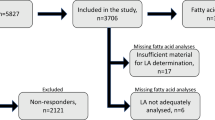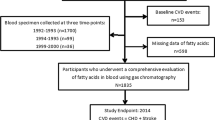Abstract
Background/Objectives:
The role of individual fatty acids in the development of cardiovascular disease (CVD) is well established, but the effects of an overall pattern of fatty acids in CVD risk has yet to be elucidated. Circulating fatty acid levels are related to metabolic disturbances associated with the metabolic syndrome and CVD, due to disturbances in the activity of enzymes that catalyse fatty acid desaturation (Δ-desaturases). Therefore, we determined patterns of fatty acids and estimated desaturase activity in plasma and analysed how these patterns were related to a 10-year CVD risk estimates in a middle-aged male population in Northern Ireland.
Subjects/Methods:
Principal components analysis (PCA) was performed for defining fatty acid patterns in 379 men aged 30–49 years. Logistic regression analyses were then carried out for analysing the relationship between these fatty acid patterns and the 10-year CVD risk estimates.
Results:
The PCA generated three high fatty acid patterns: high saturated fatty acid (SFA), high omega 3 fatty acid (omega 3) and high monosaturated fatty acid (MNFA). Results from logistic regression analyses show that a 1 s.d. increase in the SFA pattern score was significantly and positively associated with an increase in the 10-year CVD risk category (odds ratio 1.71, 95% confidence interval 1.33–2.21, P<0.0001) even after adjustment for lifestyle factors. There were no significant relationships between the other two pattern scores and the 10-year CVD risk.
Conclusions:
An unhealthy fatty acid pattern representing both dietary intake and in vivo fatty acid metabolism is related to the 10-year CVD risk estimates and provide evidence that, as with dietary patterns, the synergistic effect of multiple fatty acids may be more important in relation to the development of CVD risk.
This is a preview of subscription content, access via your institution
Access options
Subscribe to this journal
Receive 12 print issues and online access
$259.00 per year
only $21.58 per issue
Buy this article
- Purchase on Springer Link
- Instant access to full article PDF
Prices may be subject to local taxes which are calculated during checkout
Similar content being viewed by others
References
British Cardiac Society; British Hypertension Society; Diabetes UK; HEART UK; Primary Care Cardiovascular Society; Stroke Association (2005). JBS 2: Joint British Societies’ guidelines on prevention of cardiovascular disease in clinical practice. Heart 91, v1–v52.
Emken EA (1994). Metabolism of dietary stearic acid relative to other fatty acids in human subjects. Am J Clin Nutr 60, 1023s–11028s.
Folch J, Lees M, Sloane-Stanley GH (1957). A simple method for the isolation and purification of total lipids from animal tissues. J Biol Chem 226, 497–509.
Hankey GJ, Jamrozik K (1996). Risk factors for stroke: lifestyle factors. Cardiovasc Risk Fact 6, 5–17.
Hodson L, Skeaff CM, Fielding BA (2008). Fatty acid composition of adipose tissue and blood in humans and its use as a biomarker of dietary intake. Prog Lipid Res 47, 348–380.
Hu FB, Manson JE, Willett WC (2001). Types of dietary fat and risk of coronary heart disease: a critical review. J Am Coll Nutr 20, 5–19.
Keys A (1980). Seven Countries. Harvard University Press: Cambridge, MA.
Kris-Etherton P, Daniels SR, Eckel RH, Engler M, Howard BV, Krauss RM et al. (2001). AHA scientific statement: summary of the Scientific Conference on Dietary Fatty Acids and Cardiovascular Health. Conference summary from the Nutrition Committee of the American Heart Association. J Nutr 131, 1322–1326.
Kris-Etherton PM, Griel AE, Psota TL, Gebauer SK, Zhang J, Etherton TD (2005). Dietary stearic acid and risk of cardiovascular disease: intake, sources, digestion, and absorption. Lipids 40, 1193–1200.
Lopes SM, Trimbo SL, Mascoli EA, Blackburn GL (1991). Human plasma fatty acid variations and how they are related to dietary intake. Am J Clin Nutr 53, 628–637.
Lopes-Virella MF, Stone P, Ellis S, Colwell JA (1977). Cholesterol determination in high-density lipoproteins separated by three different methods. Clin Chem 23, 882–884.
Ma J, Folsom AR, Eckfeldt JH, Lewis L, Chambless LE (1995a). Short and long term repeatability of fatty acid composition of plasma phospholipids and cholesterol esters. The Atherosclerosis Risk in Communities (ARIC) Investigators. Am J Clin Nutr 62, 572–578.
Ma J, Folsom AR, Shahar E, Eckfeldt JH (1995b). Plasma fatty acid composition as an indicator of habitual dietary fat intake in middle aged adults. The Atherosclerosis Risk in Communities (ARIC) Investigators. Am J Clin Nutr 62, 564–571.
Madsen T, Skou HA, Hansen VE, Fog L, Christensen JH, Toft E et al. (2001). C-reactive protein, dietary n-3 fatty acids, and the extent of coronary artery disease. Am J Cardiol 88, 1139–1142.
Morrison WR, Smith LM (1964). Preparation of fatty acid methyl esters and dimethylacetals from lipids with boron trifluoride methanol. J Lipid Res 5, 600–608.
Pischon T, Hankinson SE, Hotamisligil GS, Rifai N, Willett WC, Rimm EB (2003). Habitual dietary intake of n-3 and n-6 fatty acids in relation to inflammatory markers among US men and women. Circulation 108, 155–160.
Raatz SK, Bibus D, Thomas W, Kris-Etherton P (2001). Total fat intake modifies plasma fatty acid composition in humans. J Nutr 131, 231–234.
Rhee SK, Kayani AJ, Ciszek A, Brenna JT (1999). Desaturation and interconversion of dietary stearic and palmitic acids in human plasma and lipoproteins. Am J Clin Nutr 65, 451–458.
Riccardi G, Giacco R, Rivellese AA (2004). Dietary fat, insulin sensitivity and the metabolic syndrome. Clin Nutr 23, 447–456.
Sacks FM, Katan M (2002). Randomized clinical trials on the effects of dietary fat and carbohydrate on plasma lipoproteins and cardiovascular disease. Am J Med 113, 13S–24S.
Vessby B (2000). Dietary fat and insulin action in humans. Br J Nutr 83, S91–S96.
Wang L, Folsom AR, Eckfeldt JH (2003). Plasma fatty acid composition and incidence of coronary heart disease in middle aged adults: the Atherosclerosis Risk in Communities (ARIC) Study. Nutr Metab Cardiovasc Dis 13, 256–266.
Warensjo E, Risérus U, Vessby B (2005). Fatty acid composition of serum lipids predicts the development of the metabolic syndrome in men. Diabetologia 48, 1999–2005.
Warensjo E, Sundstrom J, Lind L, Vessby B (2006). Factor analysis of fatty acids in serum lipids as a measure of dietary fat quality in relation to the metabolic syndrome in men. Am J Clin Nutr 84, 442–448.
Woodside JV, Young IS, Yarnell JW, Roxborough HE, McMaster D, McCrum EE et al. (1999). Antioxidants, but not B-group vitamins increase the resistance of low-density lipoprotein to oxidation: a randomized, factorial design, placebo-controlled trial. Atherosclerosis 144, 419–427.
Yarnell JW, Fehily AM, Milbank JE, Sweetnam PM, Walker CL (1983). A short dietary questionnaire for use in an epidemiological survey: comparison with weighed dietary records. Hum Nutr Appl Nutr 37, 103–112.
Acknowledgements
We acknowledge the technical assistance of Janet Lightbody, Trevor Linton and Drew McIlveen. We also thank the clinic nurses, Maureen McCourt and Geraldine O’Reilly, Kellie Byrne (nutritional assistant) and Ishbel McMillan (administrative co-ordinator). Grateful thanks to Dr Jenkinson of Shorts Brothers, plc., Belfast.
Author information
Authors and Affiliations
Corresponding author
Additional information
Contributors: PMLS developed the paper concept, carried out the statistical analysis and drafted the manuscript; JVW was involved in subject recruitment, and was involved in developing the paper concept and drafting of the current manuscript; CMcM and AB carried out the laboratory analysis and contributed to the current manuscript; CM directed the subject recruitment and sample collection and contributed to the current manuscript; AE, ISY and JWGY devised the original study design and contributed to the current manuscript.We confirm that his material is original research, has not been previously published before and has not been submitted for publication elsewhere. All co-authors of the revised manuscript have agreed to resubmission to the journal.
Rights and permissions
About this article
Cite this article
Skidmore, P., Woodside, J., Mc Master, C. et al. Plasma free fatty acid patterns and their relationship with CVD risk in a male middle-aged population. Eur J Clin Nutr 64, 239–244 (2010). https://doi.org/10.1038/ejcn.2009.144
Received:
Revised:
Accepted:
Published:
Issue Date:
DOI: https://doi.org/10.1038/ejcn.2009.144
Keywords
This article is cited by
-
Blood fatty acid patterns are associated with prostate cancer risk in a prospective nested case–control study
Cancer Causes & Control (2016)



